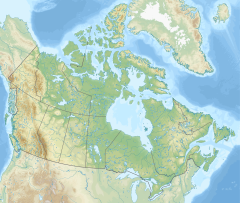Bluefish Caves
 | |
| Location | Near the Vuntut Gwichin community, Old Crow |
|---|---|
| Region | Yukon, Canada |
| Coordinates | 67°09′N 140°35′W / 67.150°N 140.583°W |
| History | |
| Founded | 24,000 BP |
Bluefish Caves is an archaeological site in Yukon, Canada, located 54 km (34 mi) southwest of the Vuntut Gwichin community of Old Crow, from which a jaw bone of a Yukon horse has been radiocarbon dated to 24,000 years before present (BP).[1] There are three small caves in the area.[2]
Context
Bluefish Cave was initially known to the local First Nations[citation needed], but was popularized by a fishing expedition in 1976, and later by researchers.[clarification needed][citation needed] This site is made up of three small caves, ranging from 10 to 30 m3 (350 to 1,060 cu ft).[3] The first cave contains various animal bones that appear to have been dragged there by predators; findings of tool marks and some tools themselves point to a human presence.[4]
The Old Crow Flats, another important area with early human presence, are located about 75 km northeast of the Bluefish Caves.[5]
Dating
The site was excavated by archaeologist Jacques Cinq-Mars between 1977 and 1987, and the initial radiocarbon dating suggested an age of 24,000 before present (BP).[6] This was considered controversial as it was in contrast to the Clovis-First theory, widely accepted by academics at the time, which considered the earliest settlement date of North America to be around 13,000 BP.[7] A review of the site in 2017 found it to be 24,000 years old,[8] lending support to the "Beringian standstill" hypothesis — that the ancestors of Native Americans spent considerable time isolated in a Beringian refuge during the Last Glacial Maximum before populating the Americas.[9] A later paper questioned the dating (based on claimed disturbances) and the culturality of the faunal remains,[10] but support for the 2017 study was reiterated by the author of that report.[11]
See also
References
- ^ Magazine, Hakai. "Archaeological Find Puts Humans in North America 10,000 Years Earlier Than Thought". Hakai Magazine. Archived from the original on 2021-01-17. Retrieved 2020-11-18.
- ^ Heather Pringle (MARCH 8, 2017), What Happens When an Archaeologist Challenges Mainstream Scientific Thinking? Archived 2021-05-12 at the Wayback Machine -- The story of Jacques Cinq-Mars and the Bluefish Caves shows how toxic atmosphere can poison scientific progress. Hakai Magazine, SMITHSONIAN.COM
- ^ "Significance of the Bluefish Caves in Beringian Prehistory | Essays | Resources For Scholars | Research | Learn | Canadian Museum of History". www.historymuseum.ca. Archived from the original on 2017-01-06. Retrieved 2017-01-11.
- ^ Saraceni, Jessica E. "New Thoughts on the Bones from Bluefish Caves - Archaeology Magazine". www.archaeology.org. Archived from the original on 2017-01-13. Retrieved 2017-01-11.
- ^ J. Cinq-Mars (2001), On the significance of modified mammoth bones from eastern Beringia. Archived 2019-03-06 at the Wayback Machine
- ^ Harington, CR; Cinq-Mars, J (2008). "Bluefish Caves- Fauna and Context" (PDF). Beringian Research Notes. 19. Archived from the original (PDF) on 2018-11-10. Retrieved 2017-01-11.
- ^ Curry, Andrew (2012-05-03). "Ancient migration: Coming to America". Nature. 485 (7396): 30–32. Bibcode:2012Natur.485...30C. doi:10.1038/485030a. PMID 22552076.
- ^ Bourgeon, Lauriane; Burke, Ariane; Higham, Thomas (2017-01-06). "Earliest Human Presence in North America Dated to the Last Glacial Maximum: New Radiocarbon Dates from Bluefish Caves, Canada". PLOS ONE. 12 (1): e0169486. Bibcode:2017PLoSO..1269486B. doi:10.1371/journal.pone.0169486. ISSN 1932-6203. PMC 5218561. PMID 28060931.
- ^ "On Way to New World, First Americans Made a 10,000-Year Pit Stop". 2017-02-27. Archived from the original on 2017-01-19. Retrieved 2017-01-11.
- ^ Kathryn E. Krasinski and John C. Blong. 2020. "Unresolved Questions about Site Formation, Provenience, and the Impact of Natural Processes on Bone at the Bluefish Caves, Yukon Territory," Arctic Anthropology 57(1): 1 1-21. doi: 10.3368/aa.57.1.1
- ^ LaurianeBourgeon. 2021. "Revisiting the Mammoth Bone Modifications from Bluefish Caves (YT, Canada)," Journal of Archaeological Science: Reports 37, 102969. https://doi.org/10.1016/j.jasrep.2021.102969
Further reading
- Heather Pringle (MARCH 8, 2017), What Happens When an Archaeologist Challenges Mainstream Scientific Thinking?—The story of Jacques Cinq-Mars and the Bluefish Caves shows how toxic atmosphere can poison scientific progress. Hakai Magazine, SMITHSONIAN.COM
- The Bluefish Caves in Beringian Prehistory by Jacques Cinq-Mars, Archaeological Survey of Canada

